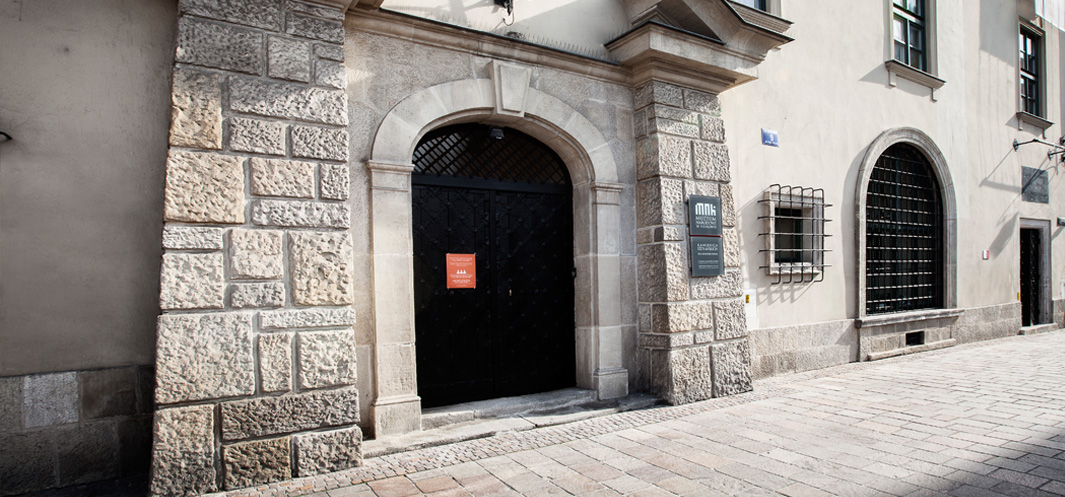On 11 December, the MNK Szołayski Branch will be open to visitors until 12:00 p.m. We apologize for any inconvenience.
Tuesday is the day of free admission to permanent exhibitions at the National Museum in Krakow.
The museum is closed on Mondays.
Tuesday is the day of free admission to permanent exhibitions at the National Museum in Krakow.
The museum is closed on Mondays.
The Szołayski house is a two-storey corner building situated near the Market Square. With its impressive façade overlooking Szczepański Square and partially Szczepańska Street, the house is adjacent to the edifices of the Stary Theatre and the Palace of Art.
The oldest part of the building was erected in the 15th century, while its present shape was achieved as a result of renovations in the 17th, 19th and 20th centuries. Initially a bourgeois property, from the second quarter of the 17th century to the end of the 18th century it belonged to the Corpus Christi order, then again became a private property.
Its fundamental development took place in the years 1815-1818, after the establishment and during the regulation of Szczepański Square. In the years 1849-1856, it housed the editorial office and printing house of Krakow's Czas newspaper. Since 1902, the building belonged to the Szołayski aristocratic family who in 1904 bequeathed it to the National Museum in Krakow. After the passing of Włodzimiera Szołayska in 1928, works on adapting the building for museum purposes started. The end of 1934 saw an official opening of the branch named after Feliks 'Manggha' Jasieński - one of the main benefactors of the Museum. During the Second World War, the building was annexed by the Germans to suit the needs of the Nazi Party.
In 2003, the Stanisław Wyspiański Museum, relocated from Kanonicza Street, opened in the Szołayski House along with a permanent exhibition dedicated to Feliks Jasieński.
After the general renovation and modernization of the building in 2012, the name of the branch was also changed - the then Wyspiański Museum was renamed as The Feliks Jasieński Szołayski House. In addition to permanent and temporary exhibitions, the branch organises lectures, concerts, theatre plays and art classes for children and youth. One section of the ground floor of the renovated building has been adapted for public service purposes, including an information centre, a museum shop, a café and a multi-purpose hall.
Ramps and lifts make the collections of the Feliks Jasieński Szołayski House available also for people with disabilities.
Its fundamental development took place in the years 1815-1818, after the establishment and during the regulation of Szczepański Square. In the years 1849-1856, it housed the editorial office and printing house of Krakow's Czas newspaper. Since 1902, the building belonged to the Szołayski aristocratic family who in 1904 bequeathed it to the National Museum in Krakow. After the passing of Włodzimiera Szołayska in 1928, works on adapting the building for museum purposes started. The end of 1934 saw an official opening of the branch named after Feliks 'Manggha' Jasieński - one of the main benefactors of the Museum. During the Second World War, the building was annexed by the Germans to suit the needs of the Nazi Party.
In 2003, the Stanisław Wyspiański Museum, relocated from Kanonicza Street, opened in the Szołayski House along with a permanent exhibition dedicated to Feliks Jasieński.
After the general renovation and modernization of the building in 2012, the name of the branch was also changed - the then Wyspiański Museum was renamed as The Feliks Jasieński Szołayski House. In addition to permanent and temporary exhibitions, the branch organises lectures, concerts, theatre plays and art classes for children and youth. One section of the ground floor of the renovated building has been adapted for public service purposes, including an information centre, a museum shop, a café and a multi-purpose hall.
Ramps and lifts make the collections of the Feliks Jasieński Szołayski House available also for people with disabilities.



